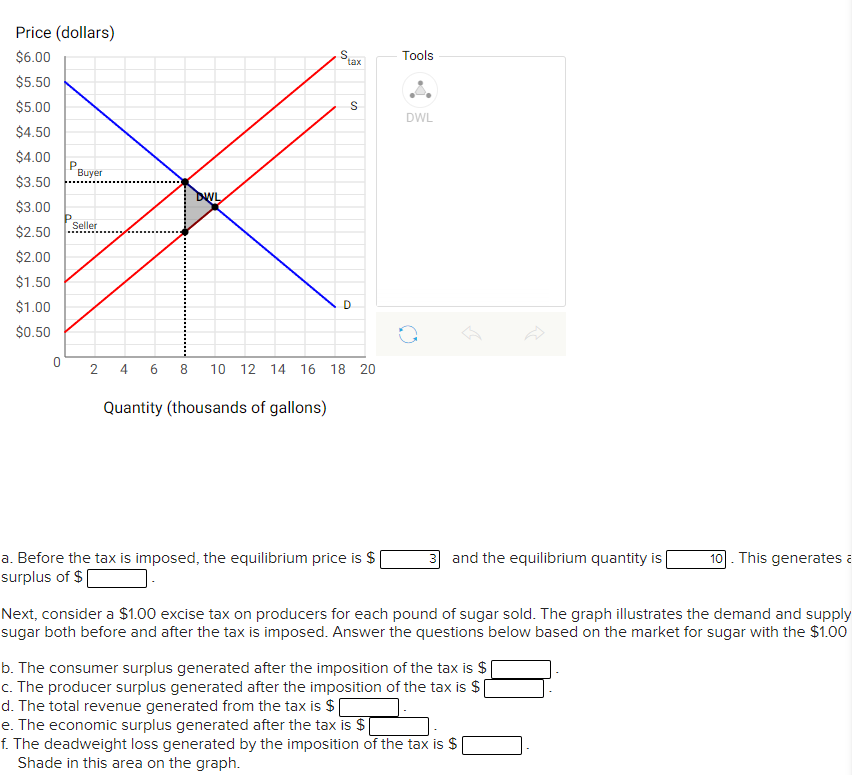Price (dollars) $6.00 S. tax Tools $5.50 $5.00 DWL $4.50 $4.00 P. Buyer $3.50 DWL $3.00 Seller $2.50 $2.00 $1.50 $1.00 D $0.50 2 4 6 8 10 12 14 16 18 20 Quantity (thousands of gallons)
Price (dollars) $6.00 S. tax Tools $5.50 $5.00 DWL $4.50 $4.00 P. Buyer $3.50 DWL $3.00 Seller $2.50 $2.00 $1.50 $1.00 D $0.50 2 4 6 8 10 12 14 16 18 20 Quantity (thousands of gallons)
Managerial Economics: Applications, Strategies and Tactics (MindTap Course List)
14th Edition
ISBN:9781305506381
Author:James R. McGuigan, R. Charles Moyer, Frederick H.deB. Harris
Publisher:James R. McGuigan, R. Charles Moyer, Frederick H.deB. Harris
Chapter3: Demand Analysis
Section: Chapter Questions
Problem 11E: Federal excise taxes on gasoline vary widely across the developed world. The United States has the...
Related questions
Question
Refer to image

Transcribed Image Text:Price (dollars)
$6.00
Tools
tax
$5.50
$5.00
DWL
$4.50
$4.00
P.
Buyer
$3.50
DWL
$3.00
Seller
$2.50
$2.00
$1.50
$1.00
D
$0.50
2 4 6 8 10 12 14 16 18 20
Quantity (thousands of gallons)
10. This generates a
a. Before the tax is imposed, the equilibrium price is $
surplus of $
and the equilibrium quantity is
Next, consider a $1.00 excise tax on producers for each pound of sugar sold. The graphillustrates the demand and supply
sugar both before and after the tax is imposed. Answer the questions below based on the market for sugar with the $1.00
b. The consumer surplus generated after the imposition of the tax is $
c. The producer surplus generated after the imposition of the tax is $
d. The total revenue generated from the tax is $|
e. The economic surplus generated after the tax is $
f. The deadweight loss generated by the imposition of the tax is $
Shade in this area on the graph.
Expert Solution
This question has been solved!
Explore an expertly crafted, step-by-step solution for a thorough understanding of key concepts.
This is a popular solution!
Trending now
This is a popular solution!
Step by step
Solved in 3 steps with 2 images

Knowledge Booster
Learn more about
Need a deep-dive on the concept behind this application? Look no further. Learn more about this topic, economics and related others by exploring similar questions and additional content below.Recommended textbooks for you

Managerial Economics: Applications, Strategies an…
Economics
ISBN:
9781305506381
Author:
James R. McGuigan, R. Charles Moyer, Frederick H.deB. Harris
Publisher:
Cengage Learning

Principles of Economics (MindTap Course List)
Economics
ISBN:
9781305585126
Author:
N. Gregory Mankiw
Publisher:
Cengage Learning

Principles of Microeconomics (MindTap Course List)
Economics
ISBN:
9781305971493
Author:
N. Gregory Mankiw
Publisher:
Cengage Learning

Managerial Economics: Applications, Strategies an…
Economics
ISBN:
9781305506381
Author:
James R. McGuigan, R. Charles Moyer, Frederick H.deB. Harris
Publisher:
Cengage Learning

Principles of Economics (MindTap Course List)
Economics
ISBN:
9781305585126
Author:
N. Gregory Mankiw
Publisher:
Cengage Learning

Principles of Microeconomics (MindTap Course List)
Economics
ISBN:
9781305971493
Author:
N. Gregory Mankiw
Publisher:
Cengage Learning

Principles of Economics, 7th Edition (MindTap Cou…
Economics
ISBN:
9781285165875
Author:
N. Gregory Mankiw
Publisher:
Cengage Learning

Principles of Microeconomics
Economics
ISBN:
9781305156050
Author:
N. Gregory Mankiw
Publisher:
Cengage Learning